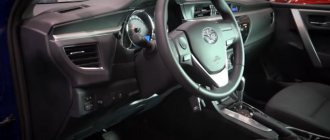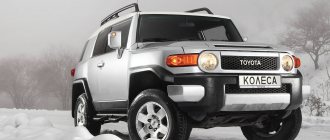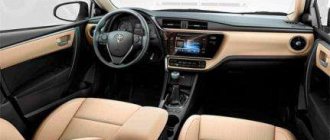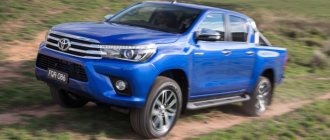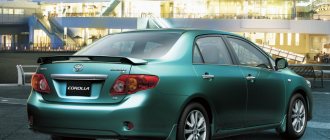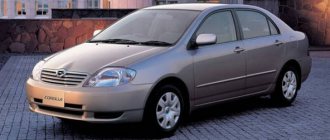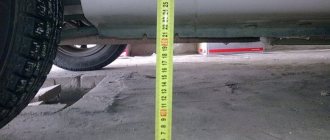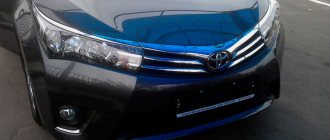The last two years have been very difficult for the Russian automobile market: car sales have seriously declined, many automobile brands have left Russia, and the remaining ones had to optimize their model range. Despite the general crisis, individual automakers managed to better cope with its consequences. Toyota continues to be one of the leaders in the domestic market, occupying an 8.3 percent share in 2021 (hereinafter, Autostat data is used). All key Japanese models - Camry, RAV4, Land Cruiser 200, Land Cruiser Prado, Hilux - are leaders in their segments. As we can see, Corolla is missing from this list. From January to June 2021, dealers were able to sell less than a thousand cars.
In August last year, sales of the updated Corolla began, and the situation has changed. Over the five remaining months of 2021, Russians purchased 2,792 cars, which is 68% more than during the same period in 2015. Let's try to figure out how restyling helped the Toyota Corolla become more successful.
By the way, Toyota Corolla is the best-selling car in the world. Over the 50-year history of the model, more than 40 million cars have been sold. And in Russia, Corolla is the most popular foreign car on the market in terms of the total number of cars of all generations.
⇡#Exterior
The noticeably refreshed Corolla now looks more like its big brother, the Camry. Of course, the design of the Corolla still cannot be called bright, but compared to its predecessor, the car has become prettier both in front and in the back.
The elongated headlights flow harmoniously into a neat chrome radiator grille. Our version is equipped with LED headlights for low and high beam, daytime running lights also consist of a strip of LEDs. The shape of the bumper has changed slightly, although on black cars this is not as noticeable as, for example, on white ones.
Triangular mirrors do not please with visibility - their sizes could be larger.
When viewed from the side, it will be difficult to distinguish the car from its competitors, but the rear of the Corolla after restyling has been slightly transformed due to LED lights.
The two entry-level trims are content with 15-inch stamped wheels, while the rest, including ours, boast 16-inch alloy wheels with 205/55 R16 tires.
In general, the restyling benefited the Toyota Corolla, refreshing the appearance of the car. The calm, but at the same time modern design will certainly appeal to buyers aged 35 years and above.
⇡#Interior
The interior of a car depends on its configuration, and the Corolla is no exception. Expensive versions are seriously different in interior from the basic ones: in the initial versions, for example, there is no 4.2-inch display on the instrument panel, so the instruments themselves look different. The car provided for testing was in the “Style Plus” configuration - only the top-end version called “Prestige” is cooler than it.
Clearly more Toyota employees worked on the interior of the updated Corolla than on the exterior design - the changes here are much more noticeable. A 7-inch LCD touch screen for the multimedia system, familiar to us from the SUVs of the Japanese company, appeared on the center console. It is surrounded by glossy plastic that quickly collects fingerprints.
A multifunction steering wheel with leather trim and heating is available with the third-lowest price of the “Style” package. The steering wheel is not heated entirely, but only in the grip zone.
The instrument panel, even in expensive versions, looks rustic, although there are no complaints about the instruments themselves - the readings are read without problems.
Among other interior elements, the most striking are the airflow deflectors, made in the form of turbines: they not only look great, but are also very convenient to use - the air flow is easy to direct in the desired direction, and its strength can be adjusted using the “twist” in the center. But the design of the buttons for turning on the heated steering wheel and windshield takes us back to the 90s. The buttons responsible for the position of the mirrors do not look any better - so it’s even good that they are almost invisible from behind the steering wheel.
But the dual-zone climate control unit with rocker keys looks very modern and is very convenient to use. Nice graphics on the display create a complete image.
Just below are the buttons for turning on the two-stage heating of the front seats - their appearance contrasts with the climate control unit. Nearby are USB and AUX connectors, as well as a 12-V socket. A small compartment for storing small items is hidden under the button block.
A large glove compartment will please those who like to store a lot of “useful” things in the car.
The fabric-upholstered seats have only mechanical adjustments, and the lumbar support cannot be adjusted in principle. The seats themselves will be comfortable for people of substantial build; slimmer drivers will feel a lack of lateral support.
The rear sofa pleases with its spaciousness - there is so much space up to the front seats that even a very tall person can sit comfortably in the back. The Corolla is one of the most spacious cars in the C-Class.
Trunk volume is 452 liters. The indicator is not bad, but the hinges of the lid may prevent you from filling it entirely. The second row seats recline in a 60:40 ratio.
⇡#Technical characteristics of Toyota Corolla
| Engine | |
| engine's type | Petrol |
| Working volume, cm3 | 1798 |
| Number of cylinders | 4 |
| Maximum power, l. With. / kW at rpm | 140/103 at 6400 |
| Maximum torque, N*m at rpm | 173 at 4000 |
| Dynamics | |
| Acceleration to 100 km/h, s | 10,2 |
| Maximum speed, km/h | 195 |
| Transmission | |
| Transmission | Variable speed drive |
| Drive unit | Front |
| Chassis | |
| Front suspension | Independent, McPherson spring type, with anti-roll bar |
| Rear suspension | Semi-dependent, spring |
| Front brakes | Ventilated disc, 277 mm |
| Rear brakes | Non-ventilated disc, 270 mm |
| Tire size | 205/55 R16 |
| Power steering | Electric |
| Body | |
| Dimensions, length/width/height, mm | 4620/1775/1465 |
| Wheelbase, mm | 2700 |
| Ground clearance, mm | 150 |
| Weight, curb (total), kg | 1260–1375 (1785) |
| Number of seats/doors | 5/4 |
| Trunk volume, l | 452 |
| Fuel | |
| Recommended fuel | AI-91 |
| Tank volume, l | 55 |
| Consumption per 100 km, urban/suburban/combined cycle, l | 8,3/5,3/6,4 |
| Current price, rub. | from 983 thousand |
Toyota Corolla for the Russian market is produced at a plant in Turkey. Perhaps this is one of the reasons for the rather high prices for a C-class car. “Base” costs a little less than a million - 983 thousand. But for this money you will get a Corolla with a 1.33-liter engine and a manual transmission, stamped, without foglights, without an audio system, without ESP, but with ABS, air conditioning and front airbags. A more or less normal option - with a CVT and a 1.6-liter engine in the "Style" package - will cost 1.18 million rubles. This Corolla already has fog lights, alloy wheels, rear electric windows, an audio system with MP3 support and a USB connector, side airbags, and a heated steering wheel.
The car provided for testing was in the “Style Plus” configuration - this will cost at least 1.24 million, and with a CVT and a 1.8 liter engine it will cost 1.31 million. This configuration includes LED low and high beam headlights, dual-zone climate control -control, 4.2″ color multifunction display on the instrument panel, Toyota Touch 2 multimedia system with a 7-inch touch screen and Bluetooth support, electrically heated windshield in the windshield wiper rest zone and other options.
The most expensive Corolla costs 1.361 million - the “Prestige” version adds to the list of equipment a keyless entry system with engine start from the Smart Entry button, rain and light sensors, electric folding mirrors, front and rear parking sensors. But this is not the limit - the cost of the car can easily be increased by options such as 17-inch alloy wheels or a navigation system by another 150-200 thousand. It’s interesting that you can’t order a leather interior in principle.
Engine
Initially, the Corolla is offered with two engines - 1.4 and 1.6. Let's talk about 1.4 first. It has 97 horses and the only advantage is that you can save on transport tax by falling into the category of up to 100 horses. The dynamics with such a motor are very weak, more than 13 seconds. Therefore, I see no point in buying a car with such an engine.
By the way, 1.4 is a motor from the “ZZ” series, which are known as “oil guzzlers”. But this does not apply to this generation, since manufacturers corrected this problem in 2005. And then, after restyling, instead of 1.4 they began to offer 1.3. The engine has become more powerful by four horses. He has 101 horses. But the dynamics are just as weak, only the tax is higher.
The 1.3 is a 1R-FE engine, the weak point of which is the EGR valve, given the quality of our fuel. Since low-quality fuel causes carbon deposits to appear in the intake manifold, the car begins to work differently than it should. Have to disassemble and clean. Knowledgeable people simply turn off the EGR immediately to avoid such troubles.
And the most popular engine on Corollas is 1.6. Engine 1ZR-FE, power 124 horses (more decent, not some 97 or 101), dynamics are already better, accelerates to 100 in 10.4, however, this is in combination with mechanics. In combination with an automatic, one and a half seconds longer. The motor is also quite trouble-free.
I have done some research on these motors and all three motors are fairly problem free. The only thing they say is that such engines are prone to oil consumption. But, as practice shows, and after talking with a couple of Toyota Corolla owners, the consumption turns out to be not so high. But another question is that one has a mileage of just over 60 thousand, and the other 100 thousand. Maybe he will start using it up after 150 thousand. But there is nothing critical in this.
But as for the boxes, initially they offered mechanics and a robot. The robot is the problem. It wasn’t installed for long, literally two or three years. And in 2009, due to the fact that there were complaints from owners and warranty claims because of this robot, they changed the robot to an automatic one. The automatic was installed from Avensis, four-speed. The car, of course, lost its dynamics. But considering the dynamics here, even in combination with mechanics, this is not worth paying attention to. At least this model has become much more reliable and problem-free.
⇡#On-board computer and multimedia system
Toyota Corolla has a classic instrument layout: the tachometer and speedometer are separated by an on-board computer display. As in many cars, the panel has dial indicators for engine temperature and fuel level in the tank.
Blue backlighting, silver rims and the fonts used - all this together looks quite simple, although there are no complaints about the information content of the devices. The display can display current or average speed, fuel consumption, daily mileage, etc.
The multimedia system, called Toyota Touch 2, includes a 7-inch touchscreen display with touch-sensitive buttons grouped around it. It’s a pity that the Japanese did not supplement the system’s display with physical buttons - the disadvantages of touch keys are obvious.
The system's capabilities are quite standard: playing music from a CD, flash drive or via the Bluetooth interface, FM/AM radio, viewing SMS messages from a smartphone, as well as the ability to make phone calls. There is no navigation here, although there is a corresponding key. You can also display information from the on-board computer on the screen - consumption, speed, etc.
The interface of Toyota Touch 2 is quite clear, but a large amount of blue color and not the best fonts somewhat spoil the impression of the system. The screen itself practically does not slow down, but the low resolution and poor fonts reduce the ease of use. In addition, the system has problems displaying ID3 tags in Cyrillic.
⇡#Corolla rules!
Marat Gabitov News feed editor Drives a Ford Mondeo
If a theater begins with a coat rack, then a car begins with a steering wheel. After all, it is the mediator between you and the roadway. When we start driving, we hold onto the steering wheel, and when it’s heated, it changes everything. You say - just think, it's a trifle! But that's not true. Over the course of a week, I drove the Corolla about a thousand kilometers around Moscow and the Moscow region, and every time I sat down in the frozen interior, I was glad of this useful option. Turn the key, put your hands on the steering wheel, and within two minutes the life-giving warmth warms your hands, which have become stiff in the cold. I think no one will mind if heated steering wheels are made a mandatory option for all cars in Russia. But these are just dreams, and there is only one mandatory option in our country - ERA-GLONASS. Among other “winter” options, the Corolla has heated rear-view mirrors, an electrically heated windshield in the windshield wiper rest area, heated front seats, and an additional electric interior heater.
Continuing the topic of steering, one cannot help but note one more pleasant thing - the steering in the restyled Corolla has been redesigned. Moreover, we are not talking about some unnoticeable cosmetic changes, but about global changes. The new Corolla is a pleasure to drive! At low speeds the steering wheel pleases with its lightness, with increasing speed the force increases - everything is as it should be.
Changes also affected the suspension - it became a little stiffer, but the roll decreased and the car became more collected. At the same time, the reserve in terms of energy intensity is still decent - the Corolla can be driven even on not the best roads; the shock absorbers only react to breakdown in very deep holes.
The Japanese say that restyled cars have received additional sound insulation. The Corolla really cannot be called a noisy car - the engine fills the interior with noise only after 3.5 thousand revolutions. So when driving quietly, the 1.8-liter engine is practically inaudible. If you switch the variator to the “Sport” mode (there is one), the Corolla can confidently stay in traffic, although it is better not to participate in traffic light races with it - it is unlikely that you will be able to win, and the roar of the variator at high speeds will quickly get your head tired.
Russian car enthusiasts are not too fond of robotic gearboxes and CVTs, preferring classic torque converter automatic transmissions - they say they are more reliable. But there are a large number of cars on the market, both with a CVT and with a robot, and you probably shouldn’t be afraid of them. Moreover, the CVT is afraid of prolonged slipping, and it is unlikely that anyone will constantly drive off-road in a passenger car. But thanks to the CVT, the Corolla in mixed mode consumes about 8 liters per hundred - a good result for a 140-horsepower car, and even during winter operation.
Salon
Having sat down in the salon, I don’t even know what to look at, what to start talking about. It's pretty boring here, there's nothing special. Even the plastic may not be cheap, but it looks somehow cheap. In the same Cruise, it seems to me that the plastic was of better quality.
The only thing that catches your eye is the steering wheel, which is supposedly covered in leather. Maybe it’s not leather, but some kind of substitute, but it looks cool. It has radio control buttons. The radio, by the way, has been changed, with a color display. The buttons on the steering wheel are connected to it. Plus, a rear view camera is additionally installed; everything is displayed here when reverse gear is engaged.
The steering wheel has such a bevel at the bottom, a la “sports car”. And it seems to me that this is a very convenient thing. Because in almost all cars, when I get into it, I have problems getting in and out. Because I always cling to my knees, and this is inconvenient. And this kind of thing helps a lot.
The equipment is average, the options here are only the most necessary:
- heated seats (and then only “on” and “off”, there are no other modes);
- The level of headlights can be changed;
- The climate is single-zone, non-automatic.
⇡#Competitors
There are quite a few mid-size sedans on the Russian market. For example, for 1.2 million rubles you can buy a Ford Focus with a 150-horsepower turbo engine and automatic transmission. “Focus” will be more dynamic (9.3 s to hundreds), with rain and light sensors. For the “extra” hundred thousand you can equip it with options in the form of adaptive bi-xenon headlights, an automatic parking system and standard navigation. The disadvantages of the Focus include a small trunk, a cramped interior and a less energy-intensive suspension.
Perhaps the most serious competitor for the Toyota Corolla is the leader of the C-class segment at the end of 2021 - Skoda Octavia. The Czechs offer buyers a choice of three petrol and one diesel engines. For 1.34 million you can buy a liftback with a 1.8-liter turbo engine producing 180 hp. With. (7.4 s to 100 km/h) and DSG robot. Sales of the updated Octavia will start this year, and the prices are already known; the new cars will be only slightly more expensive than their predecessors.
For 1.23 million you can buy the top version of the new KIA Cerato. It will be a sedan with a 2-liter engine producing 150 hp. With. (9.3 s to hundreds) and automatic transmission. The car will already have xenon headlights, a blind spot monitoring system and other interesting options.
Another Korean competitor to the Corolla is the fresh Hyundai Elantra. For 1.2 million you can buy a sedan with a 2-liter engine (150 hp, 9.9 s to 100 km/h) and an automatic transmission. An option package for 80 thousand will add 17-inch alloy wheels, xenon headlights, keyless entry and an engine start button to the car.
The German company Volkswagen also has offers for this money - a Jetta with a 1.4 TSI engine (150 hp, 8.6 s to 100 km/h) and a DSG gearbox costs the same 1.3 million rubles. Additional payment for bi-xenon - 90 thousand rubles.
A Nissan Sentra in the rich Tekna configuration costs 1.2 million - however, for this money the buyer will receive a sedan with a 1.6 liter engine and a CVT (11.3 s to a hundred). But Sentra has xenon headlights, leather interior, push-button engine start, etc. Nissan can attract buyers with a spacious interior, large trunk, but things are not very good with dynamics and handling.
Trunk
Now let's look in the trunk. To open it, you can use a key or a button in the interior. The key can be opened either through the lock cylinder or with a button on the key.
The trunk is quite large. The only problem is that the opening is narrow, so putting something bulky will be problematic. Plus, the rear seat backs recline. But you can't do this from the trunk. Can only be folded from the interior. And there is a lever on the backrests themselves, and if you set the lever to the “lock” position, then it will no longer be possible to fold the seats out of the interior.
There is also a small pocket here, very shallow, for some small items. We raise the floor, and there we have a full-size spare tire. There are no boxes or anything like that. Well, yes, of course, I would like more different pockets. And so, in principle, the trunk is normal.
